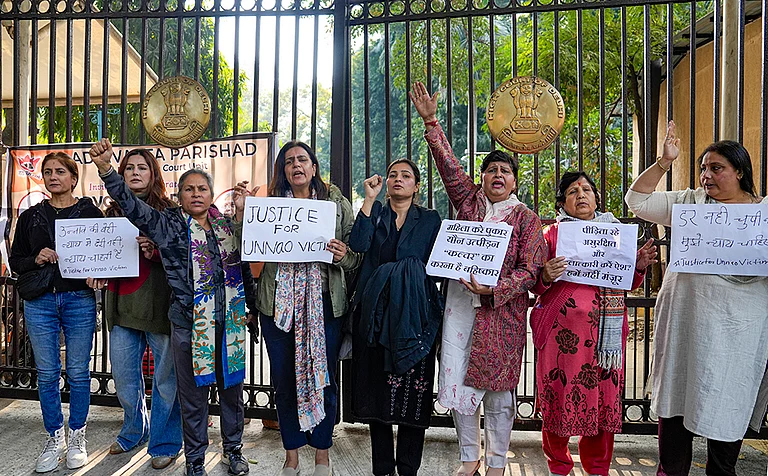If your job is reviewing Tamil movies, it’s time to take a holiday. If you are a theatre owner in Tamil Nadu, try to replay some old Tamil hits. If that fails to bring in the footfalls, shut shop and wait for a new release.
Yes, entertainment-hungry Tamil Nadu has been starved of new Tamil films since March 1 after Tamil film producers stopped releasing new movies, complaining that the digital service providers (DSPs) refused to scale down their virtual print fee (VPF) to the desired level. “We have paid up to Rs 27,500 as VPF per movie for more than a decade and we decided to correct that mistake now,” claims S.R. Prabhu, treasurer of the Tamil Film Producers’ Council. While the producers allege that the DSPs are overcharging, the service providers counter that technology costs money.
The ‘no new release’ diktat initially included all south Indian language films, but producers of Telugu, Malayalam and Kannada movies broke ranks after the two major DSPs—Qube Cinema and UFO—lowered the VPF for all four languages. “We had some big releases for Ugadi and did not want to lose out on the audience and revenue, so we took the practical way out,” admits Telugu film producer Suresh Babu.
With Rajnikanth’s Kaala slated for an April release, when school holidays begin, the pressure on Tamil producers to break the logjam would only increase. And yet the producers led by Vishal Reddy have refused to climb down. “Even if a few producers choose to release their movies, the majority of us will stick together,” Vishal asserts. That’s easier said than done as producers would want to recover their costs, having paid huge interests to financiers to fund their movies.
Industry sources say the stand-off owes to an ego clash between Vishal and the DSPs and theatres. “There is no ego,” counters Vishal. “The issue is VPF should have ended after 10 years, but it continues. Why should I continue to pay EMI for a car after I have fully repaid the loan?” The actor-producer believes rationalising the VPF was only part of his efforts to revamp the Tamil film industry, which has been suffering from poor returns, multiple flops and a backlog of unreleased movies.
DSPs actually create the master copy of the film, convert it into screenable digital format, provide security keys to make them tamper-proof, and send digital copies in hard disks or transmit them via satellites to theatres. They also supply theatres with digital players and projectors, as well as tech support to attend to breakdowns. Producers in the past used to send celluloid prints at Rs 60,000 per copy, but digital conversion has scaled it down to Rs 12,000 per print.

Refusing to blink, the Tamil producers insist that the VPF be scaled down even more (see chart)—to Rs 12,000 for three years against the Rs 21,750 now on offer. “When an Indian film is released abroad, the producers pay a VPF of $850 for unlimited screening,” says Senthil Kumar of Qube Cinema. “That is virtually the world standard, so you can see what we charge is already highly subsidised. How can a different standard exist only for Tamil cinema when other south Indian counterparts have not toed their line?”
Senthil also clarifies that VPF is essentially hire charges and not loans to be paid as EMIs. “We have invested Rs 400 crore as equipment in theatres,” he claims. Qube is credited with ushering in the digital revolution in film distribution and projection, with its own robust digital player and scalable formats. Having participated in this decade-long transition to digital, the DSP does not want to be cut out of the equation suddenly.
“In 2004, the producers had wanted digital prints to cut the costs of distribution. So the DSPs and theatres got into long-term agreements, with the former supplying the technology and equipment,” says the owner of a leading multiplex. “It was only logical that the producers pass on the money they save by way of VPF.”

Rajnikanth’s next
The multiplex owner also points out that producers essentially hired theatres and screening equipment to show their movies and shared the revenue as rent to theatres or VPF to the DSPs.
Vishal and his team of producers are angling for new DSPs, which will agree to their lower charges—essentially, for handling and tech support. But they are being accused of lowering the screening standards as their DSPs would be able to provide only e-Cinema equipment and not DCI, which has emerged as the world standard. “The world has moved to DCI (Digital Cinema Initiative) specifications, and even in India, theatres are moving from e-Cinema format to the more secure DCI, compatible across formats,” says Senthil. “They want the industry to regress to 2G in the age of 4G, when we should be looking to upgrade to 5G.”
The producers are also looking for a share in the advertising pie that now belongs only to theatre owners and the DSPs. “When theatre ads had lost out to TV ads, we created a system of projecting centrally controlled ads, which theatre owners could pick and choose at their convenience and in accordance with their market needs,” says Jayendra of Qube. “Now the producers want a share of this too since the ads are sandwiched between the content they provide. This is unfair.”
Vishal argues, however, that the interval is chosen by the producer, who can also decide to have no interval. “We only want them to screen trailers and teasers of other movies without charging anything, so other producers will benefit,” he says.
Noted film distributor Tiruppur Subramaniam accuses the producers of barking up the wrong tree under the guise of cutting costs. “If they want to cut costs, let them reduce the salaries being paid to big stars,” he says. “Most big hero films have flopped. Producers compel theatres to keep screening the movies in Chennai to mislead the heroes that their films are big hits. While producers have only served us duds, the DSPs have actually introduced new quality standards and the latest technology—and theatre owners are unwilling to compromise on those for the sake of a few producers.”
Film industry experts caution that the producers’ recalcitrant approach of going on a strike would only see more moviegoers shift from theatres to other digital streams like Amazon and Netflix or illegal torrents. Producer G. Dhananjayan, however, claims producers are only trying to create a level playing field as the VPF was unreasonably high. Dumping the present DSPs will not be easy as the theatres are bound by legal contracts with them. Moreover, with Qube and UFO—two of the biggest DSPs—set to merge, their bargaining clout would only increase. A multiplex owner was confident that one producer after another would soon break away and exhibit their movies as “no one wants to lose money”. “In this industry, money is god, and fame comes running after,” he says.
By G.C. Shekhar in Chennai


























